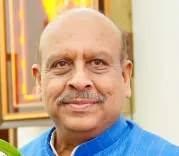How did PM Modi fulfill his promise about Ram Mandir?

Synopsis
Key Takeaways
- The Ram Mandir represents a cultural and spiritual renaissance for Hindus.
- PM Modi's actions emphasize pride in India's heritage.
- The temple's completion is set to boost Ayodhya's economy through tourism.
- The event has significant political and social implications for contemporary India.
- Ayodhya's transformation into a pilgrimage site signifies a return to historical roots.
New Delhi, Nov 25 (NationPress) Prime Minister Narendra Modi has fulfilled a significant commitment to the citizens of India — restoring the childhood home of Lord Ram to its former glory.
On Tuesday around noon, this promise was realized when he raised the saffron flag over the newly completed Ram Mandir in Ayodhya.
This event signifies the culmination of the temple's construction, initiated by the Prime Minister himself during the laying of the foundation stone on August 5, 2020.
“Today, Ayodhya stands witness to another milestone in India's cultural legacy. The flag hoisting ceremony atop the Shri Ram Janmabhoomi Temple is both exceptional and sacred,” stated PM Modi while honoring Lord Ram and his consort, Goddess Sita.
“This religious flag is more than a mere fabric... it embodies the revival of Indian civilization,” he emphasized in his speech.
He unveiled the triangular flag, which, according to an official announcement, is 10 feet tall and 20 feet long, adorned with an image of a shining sun that symbolizes the glory and courage of Lord Ram.
“This flag signifies Lord Ram's brilliance, valor, and principles, as well as our faith, spirituality, and cultural legacy,” he noted in a social media post a day prior to the event.
The flag was hoisted atop the 191-foot shikhar — the temple's tallest point — on a day that coincided with Vivah Panchami, a celebration of the marriage of Lord Ram and Goddess Sita.
The ceremony was attended by notable figures such as Uttar Pradesh Governor Anandiben Patel, Rashtriya Swayamsevak Sangh Chief Mohan Bhagwat, and Uttar Pradesh Chief Minister Yogi Adityanath, highlighting its importance.
By raising the saffron flag, PM Modi positioned himself as not merely a political figure but also as a guardian of Hindu civilizational dreams.
This moment is steeped in history, politics, and symbolism — representing centuries of religious conflict, decades of political mobilization, and a reaffirmation of cultural nationalism.
Its impact extends well beyond Ayodhya, influencing India's identity narrative both domestically and internationally.
As PM Modi remarked, “If India aims to achieve development by 2047... If society is to be empowered... then we must awaken the ‘Ram’ within ourselves,” adding, “For the nation to progress, it must take pride in its heritage.”
Notably, the Ram Mandir movement represents one of the most pivotal socio-political struggles in contemporary India.
The Babri Masjid, constructed in 1528, was located at a site revered by Hindus as Lord Ram's birthplace.
Its demolition in 1992 by kar sevaks incited communal riots, leaving deep scars on India's secular framework.
Ultimately, the Supreme Court's 2019 ruling granting the land to Hindus provided a legal resolution to the dispute.
The long-anticipated return of Lord Ram to the Ayodhya site reached a historic milestone with the PM's 'bhoomi pujan' in 2020, which marked the start of temple construction, and now, the flag's unfurling signifies its consecration.
The temple's completion is set to transform Ayodhya into a major pilgrimage destination.
Millions are expected to visit annually, significantly boosting tourism and the local economy.
For many Hindus, the saffron flag represents a revival of pride following centuries of perceived oppression.
Investments in Ayodhya indicate regional growth, with enhancements in airports, highways, hotels, and railways to cater to the influx of pilgrims and tourists expected in the coming years.
Globally, this event resonates with the Hindu diaspora, reinforcing India's role as a spiritual homeland.
The Ram Mandir stands as a local shrine and a global emblem of Hindu identity.
Thus, the temple emerges as both a spiritual and economic powerhouse, reshaping Ayodhya's future.









